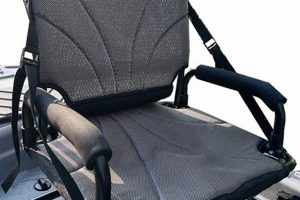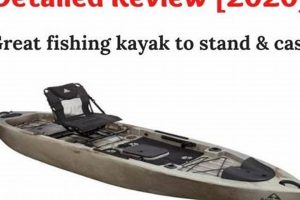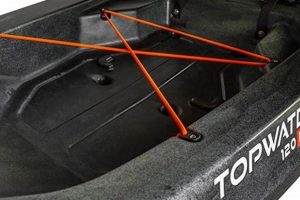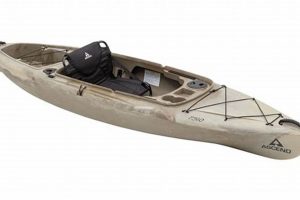This activity involves angling from a small, maneuverable watercraft designed for paddling on open waters. It offers anglers access to diverse fishing grounds, including shallow coves, reefs, and offshore areas often unreachable by larger vessels. Imagine casting a line for snapper near a rocky outcrop or trolling for salmon along a kelp forest these are scenarios made possible by the unique capabilities of this approach.
The portability and stealth of these small vessels allow for a quiet, intimate connection with the marine environment. This approach offers a distinct advantage over motorized boats, allowing anglers to approach fish without disturbing them. Historically, kayaks have been utilized for fishing for centuries by indigenous cultures worldwide, demonstrating the enduring practicality and effectiveness of this method. The modern iteration, using specialized kayaks outfitted with fishing gear, combines this heritage with contemporary technology, making the sport increasingly popular.
The following sections will delve into essential equipment, recommended techniques, suitable locations, and necessary safety precautions for a successful and enjoyable experience. This information will provide a comprehensive resource for both novice and experienced anglers interested in exploring the opportunities presented by this specialized form of angling.
Tips for Sea Kayak Angling
Preparation and knowledge are crucial for a successful and safe kayak fishing excursion. The following tips offer guidance for maximizing the experience.
Tip 1: Choose the Right Kayak: Kayak selection depends on the intended fishing environment and angler preferences. Longer kayaks offer speed and tracking for open water, while shorter kayaks provide maneuverability in tight spaces. Sit-on-top kayaks offer stability and ease of re-entry after a water landing, while sit-inside kayaks provide protection from the elements.
Tip 2: Prioritize Safety Equipment: A personal flotation device (PFD) is essential. A whistle, signaling mirror, and VHF radio are crucial for communication in emergencies. Navigation lights are important for low-light conditions.
Tip 3: Organize and Secure Gear: Rod holders, tackle boxes, and dry bags keep equipment organized and accessible. Securing gear prevents loss in the event of a capsize. A leash system can prevent paddles and rods from drifting away.
Tip 4: Understand Weather and Tides: Checking weather forecasts and tide charts before heading out is essential for safety and success. Avoid strong winds, currents, and fog. Be aware of changing conditions during the trip.
Tip 5: Practice Paddling and Maneuvering: Comfortable paddling skills are necessary for efficient movement and positioning. Practicing self-rescue techniques is vital for safety.
Tip 6: Employ Appropriate Fishing Techniques: Techniques vary depending on the target species and environment. Trolling, casting, and jigging are common methods. Downsizing tackle can improve success in a kayak.
Tip 7: Respect the Environment: Practice catch-and-release whenever possible. Properly dispose of fishing line and other waste. Avoid disturbing wildlife and sensitive habitats.
Adhering to these guidelines can enhance angling effectiveness and contribute significantly to a safe and enjoyable outing. Careful preparation allows anglers to focus on the thrill of the catch and the beauty of the surrounding environment.
The following section will discuss recommended locations for experiencing the unique rewards of sea kayak fishing.
1. Specialized Kayak Selection
Kayak selection significantly impacts the effectiveness and enjoyment of fishing expeditions. Choosing the right kayak involves careful consideration of various factors, aligning vessel characteristics with the intended fishing style and environment.
- Hull Design and Stability
Hull design directly influences stability, maneuverability, and tracking. Wider, flatter hulls offer greater initial stability, beneficial for casting and reeling. Longer, narrower hulls provide better tracking and speed, advantageous for trolling. A “V” shaped hull cuts through waves more effectively in open water while a flatter hull is more stable in calm, shallow areas. Understanding these design principles allows anglers to select a kayak appropriate for their target fishing locations.
- Sit-on-Top vs. Sit-Inside Kayaks
Sit-on-top kayaks offer excellent stability and ease of re-entry after a water landing, making them suitable for warmer climates and calmer waters. Sit-inside kayaks provide protection from the elements and offer a drier ride, better suited for colder conditions or rougher waters. Anglers should consider prevailing weather conditions and personal comfort when selecting between these two designs.
- Storage and Mounting Options
Ample storage space for tackle, rods, and safety gear is crucial. Dedicated rod holders, tackle storage compartments, and dry hatches contribute to organization and efficiency. Mounting options for fish finders, GPS units, and other electronics enhance fishing capabilities. Considering these features ensures anglers have the necessary tools and equipment readily accessible.
- Propulsion Systems (Paddle vs. Pedal)
Traditional paddle kayaks offer simplicity and affordability, while pedal-driven kayaks allow anglers to keep their hands free for fishing, offering increased efficiency. Pedal kayaks, however, are generally heavier and less maneuverable in tight spaces. Anglers must evaluate their physical capabilities, fishing style, and budget when choosing a propulsion system.
By carefully evaluating these factors, anglers can select a kayak that optimizes performance and enjoyment on the water. A well-chosen kayak enhances fishing success and safety, contributing significantly to a positive and rewarding angling experience.
2. Essential Safety Gear
Safety equipment is paramount when fishing from a sea kayak. The inherent risks associated with open water environments, combined with the specialized nature of kayak angling, necessitate specific safety precautions. A lack of appropriate safety gear can transform a routine fishing trip into a life-threatening situation. For example, an unexpected capsize without a personal flotation device (PFD) could lead to drowning, especially in cold water or challenging sea conditions. Similarly, the absence of a signaling device like a whistle or VHF radio could hinder rescue efforts if an angler becomes stranded or injured. The intimate connection with the water, while rewarding, also increases the potential for exposure to the elements, making appropriate safety gear essential for mitigating these risks.
Beyond basic flotation, essential safety gear includes communication and navigation tools. A VHF radio enables direct communication with the Coast Guard and other vessels, crucial for summoning assistance in emergencies. A signaling mirror or flare can attract attention over long distances. A GPS device and compass aid navigation, particularly in fog or unfamiliar waters. A first-aid kit equipped to handle common fishing-related injuries, such as hook removals and cuts, is also essential. Carrying spare paddle and a bilge pump provides redundancy in case of equipment failure. These precautions, though seemingly simple, contribute significantly to angler safety and preparedness.
Understanding the critical link between essential safety gear and kayak angling fosters a culture of responsible enjoyment on the water. Pre-trip equipment checks, proper gear maintenance, and familiarity with emergency procedures enhance safety. While the focus often rests on the thrill of the catch, prioritizing safety ensures anglers can continue enjoying the sport for years to come. The proactive approach to safety, rather than a reactive one, distinguishes experienced and responsible kayak anglers. This awareness underscores the importance of proper preparation and highlights the potential consequences of neglecting essential safety measures.
3. Strategic Gear Organization
Strategic gear organization is integral to successful sea kayak angling. Limited space and the dynamic nature of the on-water environment necessitate a thoughtful approach to equipment placement and accessibility. A disorganized kayak can impede fishing effectiveness and compromise safety. For example, tangled lines or misplaced tools can lead to frustration and lost fishing opportunities. In a critical situation, such as a sudden change in weather or a capsize, the inability to quickly locate essential safety gear could have serious consequences. Efficient organization transforms the kayak from a potential liability into a well-equipped and efficient fishing platform.
Several practical considerations facilitate strategic gear organization. Waterproof storage bags protect sensitive electronics and personal items. Dedicated tackle boxes with compartments for lures, hooks, and other small items prevent tangling and facilitate quick retrieval. Rod holders, strategically positioned within easy reach, keep rods secure and readily available. Leashes attached to essential items like paddles and pliers prevent loss in the event of a capsize or accidental drop. Implementing these organizational strategies minimizes wasted time searching for equipment, allowing anglers to focus on fishing and enjoy the experience. A well-organized kayak allows for efficient transitions between paddling, fishing, and handling unexpected situations. This efficiency can be the difference between a successful fishing trip and a frustrating one, particularly in challenging conditions.
Ultimately, strategic gear organization enhances both safety and fishing success in the sea kayak environment. By prioritizing accessibility and order, anglers mitigate risks and maximize their time on the water. The ability to quickly locate and deploy essential gear, whether a fishing rod or a safety device, contributes significantly to a positive and productive angling experience. This proactive approach to gear management underscores the importance of preparation and its direct impact on overall success and safety.
4. Weather and Tide Awareness
Weather and tide awareness are inextricably linked to safe and successful sea kayak angling. These environmental factors exert considerable influence on navigation, fishing conditions, and overall safety. Ignoring weather forecasts or tidal changes can expose anglers to hazardous situations, ranging from challenging paddling conditions to life-threatening emergencies. For instance, strong offshore winds can quickly push a kayak far from shore, making return difficult, especially against the wind and waves. Similarly, an incoming tide can swiftly inundate shallow fishing areas, potentially stranding an angler or creating dangerous currents. Understanding these dynamics is not merely a recommendation, but a fundamental requirement for responsible sea kayak fishing.
The practical significance of weather and tide awareness manifests in several ways. Consulting marine weather forecasts before embarking on a fishing trip allows anglers to anticipate potentially hazardous conditions, such as high winds, thunderstorms, or fog. Understanding tidal patterns helps identify optimal fishing times, as fish behavior often correlates with tidal changes. Awareness of current direction and strength is crucial for navigation and drift fishing techniques. Moreover, knowledge of local weather patterns, such as predictable afternoon sea breezes or seasonal fog banks, enables proactive planning and informed decision-making on the water. Neglecting these factors can lead to unexpected challenges, jeopardizing both fishing success and angler safety. For example, launching a kayak into a strong ebb tide without considering the potential for rapid offshore drift can create a dangerous scenario, particularly for inexperienced paddlers.
In summary, weather and tide awareness constitutes a cornerstone of safe and effective sea kayak angling. These environmental influences demand respect and understanding. Pre-trip planning, including consultation of weather forecasts and tide charts, is essential. Continuous monitoring of conditions during the fishing trip, coupled with a willingness to adapt plans based on observed changes, further enhances safety and success. Failing to prioritize weather and tide awareness can transform a recreational outing into a perilous undertaking. This understanding underscores the inherent connection between environmental awareness and responsible enjoyment of the sport.
5. Efficient Paddling Technique
Efficient paddling technique is fundamental to successful fishing from a sea kayak. It directly impacts boat control, positioning, and overall fishing effectiveness. A strong paddling foundation allows anglers to navigate efficiently, cover greater distances, and maintain optimal positioning for presenting lures or bait. Conversely, inefficient paddling can lead to fatigue, reduced boat control, and missed fishing opportunities. This connection underscores the importance of developing sound paddling skills before venturing out to fish from a sea kayak.
- Forward Stroke
The forward stroke propels the kayak forward and forms the basis of efficient movement. A proper forward stroke involves a combination of core rotation, blade angle, and a smooth, powerful pull through the water. Examples include high-angle paddling for speed and low-angle paddling for sustained cruising. In the context of fishing, a well-executed forward stroke enables precise maneuvering to approach target areas quietly and efficiently, maximizing fishing opportunities.
- Reverse Stroke
The reverse stroke stops forward momentum and allows for controlled backward movement. It is essential for maneuvering in tight spaces, repositioning for a cast, or backing away from obstacles. A strong reverse stroke allows anglers to maintain precise boat control, particularly in dynamic environments like rivers or near structures. This control can be crucial for avoiding snags or repositioning for a better presentation to fish.
- Sweep Stroke
Sweep strokes turn the kayak efficiently without requiring forward or backward movement. A forward sweep stroke turns the bow away from the paddling side, while a reverse sweep stroke turns the bow toward the paddling side. These strokes are vital for maneuvering around obstacles, adjusting position for a drift, or quickly changing direction to follow fish. Mastery of sweep strokes allows for seamless transitions between paddling and fishing, maximizing efficiency on the water.
- Draw Stroke
The draw stroke moves the kayak sideways, allowing for precise lateral adjustments without changing the boat’s orientation. This stroke is crucial for navigating close to structures, maintaining position in currents, or approaching fish from a desired angle. The ability to subtly adjust position with a draw stroke can significantly improve fishing presentations and increase catch rates.
These core paddling techniques form the foundation of efficient movement and boat control in a sea kayak. Proficiency in these strokes allows anglers to navigate effectively, position themselves strategically for fishing, and conserve energy for the task at hand. By mastering these fundamental skills, anglers transform their kayak into an extension of their angling prowess, maximizing both enjoyment and success on the water. This connection between paddling technique and fishing effectiveness highlights the importance of developing a comprehensive skill set for successful sea kayak angling.
6. Appropriate Fishing Methods
Appropriate fishing methods are intrinsically linked to the unique characteristics of sea kayak angling. The platform’s stability, maneuverability, and proximity to the water necessitate specific techniques distinct from those employed in larger vessels. Choosing methods tailored to the kayak’s attributes and the target species significantly impacts fishing success. For example, trolling heavy tackle designed for deep-sea fishing from a large boat proves impractical and potentially destabilizing in a kayak. Conversely, lighter tackle and techniques like jigging or casting, suited to the kayak’s smaller scale and closer proximity to the water, enhance effectiveness and control. This adaptation of methods to the specific environment of the kayak is fundamental to a productive and enjoyable fishing experience. Choosing the right fishing method, given the limitations and advantages of a sea kayak, becomes a crucial element of success.
Several factors influence the selection of appropriate fishing methods. Target species dictate lure choice, line weight, and retrieval techniques. Water depth and structure influence the effectiveness of different methods. For instance, bottom fishing with heavier weights proves effective in deeper channels, while lighter lures and topwater techniques excel in shallow flats. Current strength and direction also play a role, particularly in techniques like drifting or trolling. Adapting to these conditions allows anglers to maximize their chances of success. For example, in strong currents, using heavier jigs or anchoring strategically ensures lures remain at the desired depth and presentation, increasing the likelihood of attracting fish. The kayak angler’s ability to adapt fishing methods to the dynamic conditions encountered on the water distinguishes successful outings from unproductive ones.
In conclusion, appropriate fishing methods are not merely a matter of preference but a critical aspect of effective sea kayak angling. They represent the intersection of the kayak’s unique characteristics with the dynamic aquatic environment and the behavior of target species. Understanding these interconnected elements allows anglers to make informed decisions about tackle, techniques, and strategies, ultimately enhancing fishing success and enjoyment. The challenges posed by the sea kayak environment, such as limited space and the need for constant balance, necessitate a thoughtful and adaptable approach to fishing methods. This understanding underscores the intimate connection between appropriate techniques and the overall experience of fishing from a sea kayak.
Frequently Asked Questions
This section addresses common inquiries regarding angling from a sea kayak, offering concise and informative responses to clarify potential uncertainties and enhance understanding of this specialized fishing approach. The information provided aims to equip prospective kayak anglers with the knowledge necessary for a safe and rewarding experience.
Question 1: What are the primary advantages of fishing from a sea kayak?
Kayaks offer unparalleled access to shallow, secluded fishing grounds inaccessible to larger boats. Their quiet operation minimizes disturbance to fish, enhancing angling success. The physical engagement of paddling provides an immersive outdoor experience.
Question 2: What type of sea kayak is best suited for fishing?
The optimal kayak depends on individual fishing styles and target locations. Longer kayaks excel in open water, while shorter models offer maneuverability in tighter areas. Sit-on-top kayaks provide stability, while sit-inside kayaks offer protection from the elements. Specialized fishing kayaks often feature built-in rod holders and storage compartments.
Question 3: What essential safety precautions should one take when fishing from a sea kayak?
Wearing a personal flotation device (PFD) is paramount. Carrying a VHF radio, signaling devices, and a first-aid kit is crucial. Checking weather forecasts and tide charts before departure is essential. Informing someone of the planned fishing location and estimated return time is a prudent safety measure.
Question 4: What fishing gear is recommended for sea kayak angling?
Rods and reels suited to the target species are essential. A selection of lures, hooks, and lines appropriate for the intended fishing techniques is recommended. A landing net, pliers, and a knife are valuable tools. A tackle box or bag designed for kayak use facilitates organization and accessibility.
Question 5: How does one manage gear effectively in the limited space of a sea kayak?
Utilizing waterproof storage bags and compartments protects sensitive equipment. Rod holders secure rods and keep them readily accessible. Leashes prevent loss of essential tools. Strategic placement of frequently used items maximizes efficiency and minimizes clutter. Prioritizing organization enhances both safety and fishing effectiveness.
Question 6: What are the typical costs associated with getting started with sea kayak fishing?
Costs vary significantly based on kayak choice, fishing gear selection, and additional accessories. Entry-level setups can be relatively affordable, while high-end kayaks and specialized equipment can represent a more substantial investment. Used kayaks and gear offer a cost-effective entry point for those exploring the sport.
Understanding these key aspects of kayak angling contributes significantly to preparedness, safety, and enjoyment. Thorough planning and thoughtful consideration of these factors empower individuals to embark on rewarding fishing excursions with confidence.
The next section will provide detailed information regarding recommended locations suitable for experiencing the unique advantages of sea kayak fishing.
Conclusion
Angling from a sea kayak offers a unique blend of challenge, reward, and intimate connection with the marine environment. This pursuit necessitates careful consideration of equipment, technique, and safety protocols. From specialized kayak selection and strategic gear organization to proficient paddling technique and appropriate fishing methods, each element contributes significantly to a successful and safe experience. Weather and tide awareness, coupled with a respect for the environment, further distinguishes responsible kayak anglers. This comprehensive approach transforms a simple fishing trip into a rewarding exploration of coastal waters and a deeper understanding of the delicate balance within aquatic ecosystems.
The allure of angling from a sea kayak extends beyond the pursuit of fish; it represents a journey of skill development, environmental awareness, and personal growth. The challenges inherent in this activity foster resilience and adaptability, while the rewards extend beyond the catch to encompass a deeper appreciation for the natural world. As this specialized form of angling continues to gain popularity, responsible practices and a commitment to conservation will ensure its sustainability and preserve the pristine environments that make it so rewarding. The future of this pursuit rests upon the collective responsibility of those who embrace its unique challenges and rewards.






